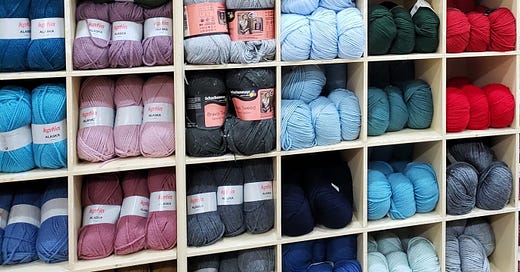Letter From Jodie Morgan: Founding Editor
Exciting news! I've been hard at work on something special these past few weeks: the next installment in my Success Manuals series.
After Knitting Habits and Crochet Habits, I'm thrilled to announce the third…
Yarn Habits! This guide is all about helping you make the most of that essential element of our craft. As I mention in the opening chapter:
"Yarn. Our craft’s building block, how we express our creativity, and sometimes, the bane of our existence when it tangles!"
As with my previous manuals, I want to ensure this one provides real value to you, my wonderful members. That's where you come in!
In this special edition of What To Crochet Next, I’m sharing a sneak peek of what I've written so far for the All The Colorways chapter.
It's still a work in progress, but I'd be so grateful for your thoughts and feedback.
Please leave a comment, hit reply, or email me at jodie@yarnbay.org with any suggestions or ideas. As a thank you, I’d like to give you a complimentary month of membership, a mention in the acknowledgements, and, of course, a complimentary copy of the finished Success Manual!
Have a read below…
Excerpt From The Yarn Habits Success Manual
Chapter 5. All The Colorways
Finding Your Perfect Palette
Different dyeing techniques create unique colorways.
Hand-dyeing often produces more varied and unique colorways than commercial dyeing. I once bought a skein of hand-dyed yarn that looked different when wound into a ball – what a surprise!
Different techniques create such unique effects:
Immersion dyeing: submerging yarn in a dye bath for solid colors.
Kettle dyeing: semi-solid colorways with subtle variations.
Hand-painting: applying dye directly to yarn for precise color placement.
Speckling: flicking or spraying dye onto yarn.
Gradient dyeing: gradually changing colors along the length of the yarn.
Space dyeing: applying multiple colors to different sections of the yarn.
Commercial dyeing produces more consistent colorways.While they lack the uniqueness of hand-dyed yarns, they're reliable for large projects where color consistency is crucial. I learned this the hard way when I ran out of hand-dyed yarn halfway through a shawl and couldn't get an exact match!
Fiber content affects how yarn takes dye:
Protein fibers (wool, silk) absorb dye readily, producing rich colors.
Plant-based fibers (cotton, linen) are more challenging to dye, creating softer, more muted tones.
Synthetic fibers produce saturated colors that resist fading.
Types Of Colorways
Solid: one consistent color throughout.
Semi-solid: subtle variations of one color.
Tonal: different shades of the same color family.
Variegated: multiple colors in short repeats.
Self-striping: long repeats of colors that create stripes.
Speckled: a base color with flecks of other colors.
Variegated and self-striping yarns are tricky. They look gorgeous in the skein but can pool in unexpected ways. To avoid pooling, try alternating skeins every few rows, even if they're from the same dye lot. For self-striping yarns, pay attention to your stitch count. It affects how the stripes form.
Tips for choosing colorways:
Think about the project's purpose: A bold, variegated yarn might be perfect for a statement scarf but overwhelming for a large sweater.
Sample before committing: Make a small swatch to see how the colors work up in your chosen stitch design.
Colorwork techniques like Fair Isle or intarsia can showcase multiple colorways in one project. When choosing colors for these techniques, consider how they'll interact. A high contrast between colors can make them pop, while similar tones create a more subtle effect.
Understanding color theory can help you choose yarns that work well together:
Complementary colors (opposite on the color wheel) create vibrant contrasts.
Analogous colors (next to each other on the wheel) create harmonious blends.
Triadic color schemes (three colors evenly spaced on the wheel) offer balanced, vibrant combinations.
Don't be afraid to step out of your comfort zone. I once paired a bright red with a deep teal, and the result was stunning!
The way we perceive color changes depending on the light. Natural daylight gives the truest representation of color. Incandescent bulbs cast a warm yellow glow, while fluorescent lights can make colors appear cooler.
I recommend checking your yarn in different places before starting a project. What looks like perfect under shop lights might clash in your living room!
What are your thoughts on that chapter? Is there anything else I should cover in the Yarn Habits Success Manual?
Share your thoughts by leaving a comment below, hitting reply, or emailing me at jodie@yarnbay.org.
As a thank you for your feedback, you'll receive a complimentary month's membership, credit in the acknowledgements, and a finished copy!
P.S. Don’t forget to become a VIP member for even more crochet inspiration…





